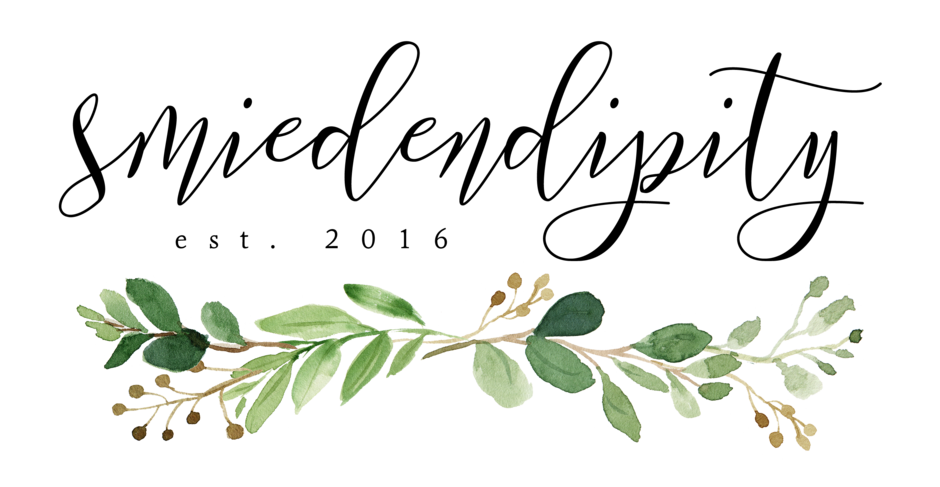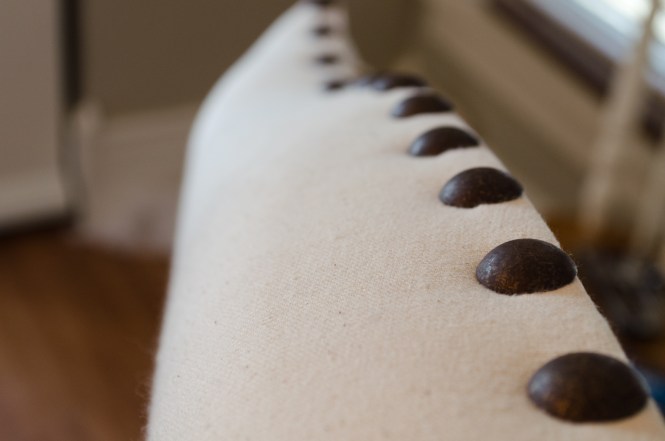Ever since we moved in a few years ago, I’ve dreamed of turning our little porch into a cozy seating area where we can sit and have breakfast, drink coffee, and people watch on pretty spring/summer/fall mornings. I can also picture snuggling out here with Baby Smied someday 🙂 My inspiration has always been this photo: blue beadboard ceiling (so southern!), wicker furniture + white cushions.

We have a seating area in the works thanks to my mother-in-law who gifted us Jeremy’s Grandma’s old wicker furniture, that we repaired/refinished and will be featuring in an upcoming post! First though, I wanted a little curb appeal. I’ve always loved oversized signs on porches that can be read from the street, I find them so welcoming and charming, and we had just the perfect blank wall space right next to our front door.
 My original inspiration for this piece was this sign I found online – I often see things like this and think “I can make that myself!”
My original inspiration for this piece was this sign I found online – I often see things like this and think “I can make that myself!”
Rustic Metal Welcome Sign from Antique Farmhouse
So, let’s make a sign!
Materials List
1/4″ piece of plywood (we used birch leftover from our bed project)
Chalkboard Paint
White Paint
Small Foam Roller
Small Paintbrush (fine tip)
White Chalk (I used my trusty old Crayola)
Pencil
Dropcloth
2 Wall Screws
2 Eyelet Screws
Drill
I used a piece of scrap birch plywood from our bed project for this, that just happened to be the right size for the space. You’ll need to cut the plywood down to 12″ x 48″ if you want a sign this size.

For the letters, I printed out each letter of “welcome” in the Archer Bold font, size 500. Trim the letters down and lay them out to be sure they fit, and you’re happy with the font size.


Lay out your dropcloth, place the birch on top, and paint with 2-3 coats of chalkboard paint. I didn’t prime beforehand, and find that I get the nicest finish by using a foam roller – don’t forget to paint the sides!


As you can see, I’ve gotten a LOT of use out of this little quart of chalkboard paint. I may or may not have also spilled some on the basement floor at one time…oops.

For chalkboard lettering, I often freehand, but I’m going to share a little secret with you if you don’t love your handwriting: the Transfer Method. For this sign I wanted the spacing to be as uniform as possible, which can be really hard to freehand, especially with a vertical orientation. Lay your letters out on the board exactly where you want them. Tape each piece to the board on the left side to hold it in place. For extra precision, have a cat come give it a second look to ensure it’s laid out correctly.

Perfect. Thanks, Murph.
Next, follow these steps for each letter:
While keeping the paper taped to the board, flip the page over and smear chalk on the back side of the paper. Flip the paper back over, and firmly trace the letter with a sharpened pencil. This will transfer the chalk outline to your sign – easy peasy.




I used a spare white chalk marker to darken the outline so I could ensure a really clean edge before painting – this step is optional. There will be leftover chalk dust on the sign, but you can wipe that off with a damp towel once the paint has dried. Once all of the outlines are done, it’s time to paint!

For the letters, I used some spare Benjamin Moore White Dove (my favorite white of all time) that we had lying around. This step is simple – with a small artist’s paintbrush, just stay within the lines! I only did one coat because I wanted this sign to have a handmade/imperfect feel, and one coat will leave just enough of an uneven finish for that. Once you’re done painting, let it dry for a few hours (I left mine overnight).

Now it’s time to hang your sign! I wanted mine to hang from eyelet screws, it reminds me of old gas station/Americana signs which are just adorable. Thankfully, we had two old screws in just the right place from some swag hooks we tried to remove when we moved in. I’m not exaggerating when I say there were no fewer than 5 swag hooks in each room of this house when we moved in…I would post photos for proof, but that would require a blog post of it’s own. Let’s just say that no one needs that many swag hooks. EVER.
Measure where you’d like your wall screws and eyelet screws to match up, and drill pilot holes to avoid splitting the wood. We used a 5/32 bit for this. Then slowly screw in the eyelets. Hang on the wall screws, ensuring everything is level. You can adjust the eyelet screws by a few turns if you need to adjust to make it level.

 This handsome fella has a serious love for everything Dewalt.
This handsome fella has a serious love for everything Dewalt.




Now you’re done: instant curb appeal! It was such a short and simple project (my favorite kind!), that cost $0 because I was able to use materials I already had lying around. What a cute result! What do you think? Hopefully this will inspire you to make your own!








 Materials List
Materials List









 1. Stencil or freehand (we freehanded) the shape of your headboard on your 4’x8′ piece of birch plywood. Cut out your shape with a jig saw. Sand down any rough edges left by the saw, we used an orbital sander with a 220 grit pad to get a really smooth edge.
1. Stencil or freehand (we freehanded) the shape of your headboard on your 4’x8′ piece of birch plywood. Cut out your shape with a jig saw. Sand down any rough edges left by the saw, we used an orbital sander with a 220 grit pad to get a really smooth edge.




































